Acne treatments nowadays range from powerful hormonal medications to topical creams with robust active ingredients. But what about the age-old methods that served people well for centuries?
Tea tree oil is a time-honored treatment that has been used for hundreds of years. So does it reduce acne?
The short answer is ‘yes’. In recent years, research has shown tea tree oil to be an effective treatment in the fight against acne. But despite this evidence, it still retains an ‘underdog’ status and often isn’t recommended as a viable treatment for those suffering from acne.
Let’s take a look at some of the amazing benefits of tea tree oil and discuss why it is not one of the most popular acne treatments available today.
Evidence Behind Tea Tree Oil for Acne Treatment
Let’s start by looking at some of the most important studies that showed tea tree effective for acne:
The first study compared 5% tea tree oil to 5% benzoyl peroxide gel, a popular choice for acne treatment. The results were very interesting. After three months, benzoyl peroxide was found to reduce inflamed lesions slightly more than tea tree oil – the final tally being 68% vs. 49%.
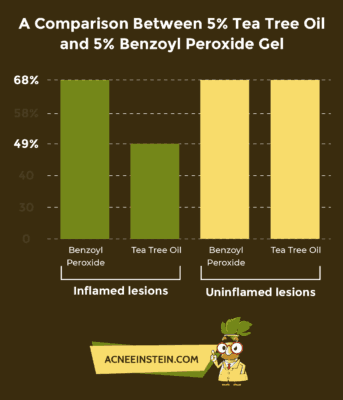
However, both products were equally effective at reducing uninflamed lesions. Those using benzoyl peroxide also noted more side effects like stinging, burning, and dry skin. Overall, this study showed that benzoyl peroxide was slightly more effective, but both options were viable treatments and proven to reduce acne by significant amounts.
Another study compared tea tree oil to a topical erythromycin, a antibiotic that is popularly prescribed for severe acne. After six weeks, the average pimple reduction in the tea tree oil group hit 55%, compared to just 40% in the antibiotic group.
A review of studies performed between 2005 and 2014 found that products containing tea tree oil can reduce acne lesions anywhere from 23.7% to 62.1%. These studies together present very strong evidence that the acne-fighting effects of tea tree oil are comparable to many other commonly-used anti-acne treatments on the market today.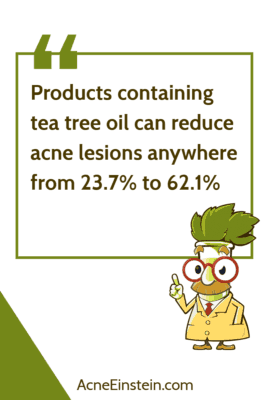
What Makes Tea Tree Oil So Effective Against Acne?
So what is it that makes this natural oil so effective against pimples and acne lesions? Most anti-acne products contain five important traits that help improve the skin. Let’s take a look at these properties and see how tea tree oil measures up.
- Antibacterial – bacteria grows in blocked pores and causes irritation and inflammation in the area. A harmlessly blocked pore can quickly turn into an angry pimple with the presence of bacteria. Benzoyl peroxide, antibiotic creams, and tea tree oil all contain antibacterial properties.
- Antioxidant – the process of acne formation is triggered by oxidative damage to components in sebum. Antioxidants are vital because they help protect the sebum from factors that cause oxidative damage, including UV rays and air pollution.
- Anti-inflammatory – when cells are damaged or exposed to bacteria, they hit their own version of the ‘panic button’, calling in an immune response. It is this immune response that results in inflammation. Anti-inflammatory acne treatments reduce the intensity of this response, or in other words, they deactivate the ‘panic button’ altogether.
- Keratolytic – when skin cells produce too much keratin, the keratin binds the cells together and makes it harder for dead skin cells to separate and shed. This, combined with too much sebum, causes blocked pores, which then lead to pimples. Keratolytic substances like retinoid creams or salicylic acid either reduce keratin production, or dissolve it and allow the dead skin cells to be shed properly.
- Sebum-reducing – if your skin produces more sebum, it’s probably more sensitive to oxidative damage. This, in turn, makes it more likely for blocked pores. So many anti-acne products focus on reducing sebum production in the skin.
Most acne medications work by addressing one or more of the proximal causes of acne: bacteria, inflammation, excess keratin, and excess sebum. Tea tree oil actually addresses two of the four proximal causes of acne: bacteria and inflammation. You’ll achieve much better results with tea tree oil if you combine it with products that can address the issues of excessive sebum and keratin production in the body. Combining tea tree oil with salicylic acid and green tea creams would cover all bases and prove to be an effective treatment for acne.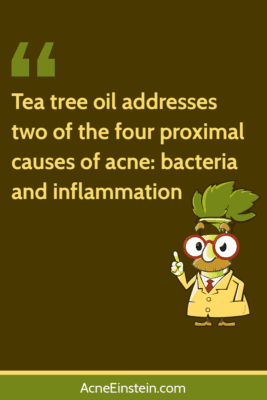
Side Effects of Tea Tree Oil
Some studies found that the application of this oil to the skin can cause minor side-effects including stinging, itching, redness, and dryness. However, it’s important to recognize that these are not far-fetched from side effects caused by other topical acne treatments.
In fact, the rates of adverse effects were higher in benzoyl peroxide and erythromycin than in tea tree oil. Many people suffering from acne also have naturally more sensitive skin, which can contribute to their reactions to treatments like tea tree oil or topical antibiotics.
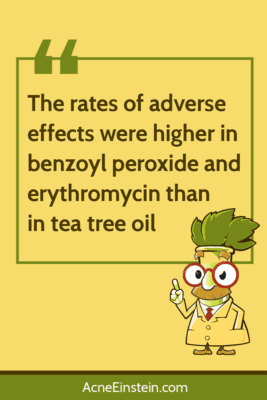
Keeping in mind these side effects, let’s take a look at some of the best ways to use tea tree oil to boost anti-acne effects and minimize stinging, redness, and irritation.
How to Use Tea Tree Oil for Acne
Before we start exploring the best ways to use tea tree oil, it’s important to note that while studies have shown 5% concentration effective for acne, most readily available products don’t contain this much.
Unfortunately, there’s no way to know exactly how much tea tree oil in any given product by simply looking at the ingredients label. One good rule of thumb is that if tea tree oil is not listed under the first five ingredients, there’s probably not enough within that product for it to be effective.
With that disclaimer, we’ve established that tea tree oil is still effective for acne treatment. Let’s now take a look at the top treatments out there.
Tea Tree Oil Creams and Gels
Perhaps the best way to use tea tree oil for acne is to apply the oil topically as a cream or gel. One of the best creams you can use for this purpose is Nature’s Plus Tea Tree Antiseptic Thursday Plantation Cream. If you take a look at the ingredients, the active ingredient is ‘Mellencamp Alternifolia (Tea Tree) Leaf Oil 5%’ – exactly what we’re looking for in an acne-fighting product.
Thursday Plantation is a brand well known for its high-quality tea tree oil products. This particular product has a great value and is backed up by dozens of positive reviews, many from people who have used the cream to treat their own skin ailments such as acne.
Another Thursday Plantation product worth looking into is the Tea Tree Medicated Gel for Acne. This is a much stronger option, with 20% tea tree oil concentration. This works well as a specific spot treatment, rather a product you rub over your entire face. Simply dab the gel over the existing pimple and watch it heal much faster. It can also be used preventatively in problem areas such as around the mouth, nose, jawline, or forehead.
Derma E Tea Tree & E Antiseptic Creme Treatment is another popular option for treating acne. Not only does it contain the 5% tea tree oil that we’re looking for, but it’s also packed with vitamin E. Vitamin E provides additional protection against UV radiation and air pollution, both of which can affect sensitive skin. For those with oily skin, this particular cream may be too heavy so a lighter cream or gel may be a better option.
The strong scent of tea tree oil can be hard to handle for some. Others love it! The good news is that regardless of whether you love it or hate it, the smell subsides within minutes of application.
Tea Tree Oil Face Washes, Scrubs, and Toners
Tea tree oil can also be found in various face washes, scrubs, and toners. If you’re looking for a product to complement your tea tree oil gel or cream, here are some good options available for you:
Desert Essence Thoroughly Clean Face Wash is a strong choice. It is made from entirely natural ingredients and great for sensitive skin. It also contains healing botanicals like jojoba and aloe, along with the tea tree we’re seeking.
The Body Shop Tea Tree Skin Clearing Facial Wash is a great product that is 100% vegan, if that’s what you’re looking for. The Body Shop is a prestigious brand, so you can expect high-quality ingredients including hand-harvested and steam-distilled tea tree oil. There isn’t enough tea tree oil in this product to use it as a single acne treatment, but it’s a great option for those looking to add a face wash to their existing skin regime.
Tea Tree Oil Exfoliating Scrub with Activated Charcoal, Neem Oil & Natural Pumice by Oleavine TheraTree is a fantastic scrub with the addition of neem oil for extra antimicrobial coverage. For maximum effect, use the product once or twice a week to exfoliate your skin. The product exfoliates dead skin with micro volcanic pumice and white willow bark, prepping the skin for a lotion or cream. This scrub would therefore be ideal to use before your 5% tea tree oil cream or gel.
In general, face washes aren’t very effective against acne. This is due to the relatively short contact time they have with the skin. Most face washes are only on your face for a moment or two before they are rinsed away, without enough time for the ingredients to be properly absorbed.
If you are searching for a good quality toner, take a look at the Clarifying toner with MSM, Tea Tree & Neem Hydrosol by Olivine. It is a nice basic tea tree oil toner with neem for added antibacterial effects. It is gentle and leaves your skin moisturized, with a fresh smell of cucumber. However, it doesn’t contain enough acids to properly exfoliate the skin, making it doubtful to actually heal acne scars.
Using Tea Tree Oil as a Spot Treatment
Some people prefer to utilize pure 100% tea tree oil as a spot treatment by putting it directly on the spot with a cotton swab. We recommend that you be extremely careful if you are wanting to try this method.
You should always see how your skin reacts to the oil first and test it on a part of your skin that is not visible, like behind your ears. It’s also important to use a high-quality tea tree oil product and only use it on small areas.
Excluding the method we mentioned above, you should never use 100% tea tree oil directly on the skin as it can burn and leave your skin irritated. Many people have recommended to dilute the oil with water. However, studies show that tea tree oil does not dissolve properly in water.
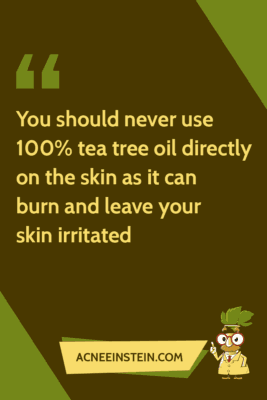
Instead, you should look for a carrier oil to mix with your tea tree oil. Choose an oil with a lot of linoleic acid such as evening primrose oil, hemp oil or rosehip oil. Whatever you do, steer clear of olive oil as a carrier oil.
Alcohol is another good solvent for tea tree oil, but since it can dry out your skin, it’s not a good option in this case.
Here’s how to make a spot treatment from tea tree oil
- Grab your pure tea tree oil and carrier oil of choice. You’ll also need a bowl and some cotton swabs.
- Estimating that a teaspoon contains about 100 drops, mix in five drops of pure tea tree oil to achieve the 5% concentration you need.
- Try the treatment behind your ear or on your neck to see how your skin reacts first. If you don’t experience any adverse reaction within 24 hours, you’re safe to use it on your face.
- Dip a cotton swab into your mixture and apply carefully to the affected area. There’s no need to rub it in or coat the entire face. Focus only on the pimple(s) and dab gently.
- Repeat until the affected area has subsided.
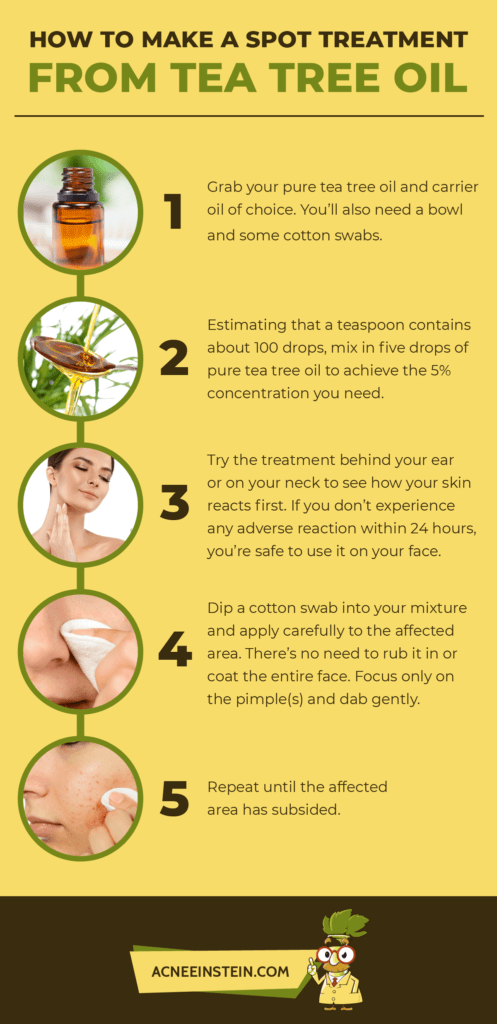
Does Tea Tree Oil Reduce Acne Scars?
Acne scars are the dark spots left over after the active acne resolves itself. The medical term for this is ‘hyperpigmentation’. Many people end up even more self-conscious about their scars than their previous acne because they can take months, or even years, for acne scars to fade away completely.
Luckily, there are a number of things you can do to speed up the healing process of acne scars. However, tea tree oil does not appear to be one of them. There is little to no evidence that tea tree oil works with acne scars, as it doesn’t affect melanin formation or transportation (the only known ways to reduce hyperpigmentation).
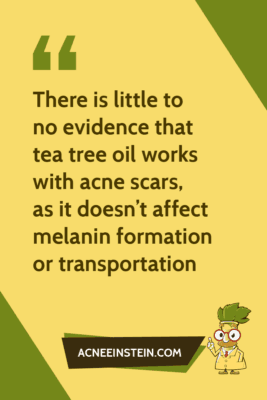
So Should I Add Tea Tree Oil to My Acne Regimen?
Tea tree oil does have a positive effect on acne and reduces lesions by fighting inflammation and killing bacteria on the skin. But to achieve the very best results, don’t forget to use tea tree oil alongside with other products that fight excess sebum and keratin production.
If you have been struggling with acne but have never given tea tree oil a chance, perhaps you could consider introducing it to your daily skincare routine using one or more of the methods mentioned above. Don’t forget to share with us your experiences with tea tree oil for acne treatment!

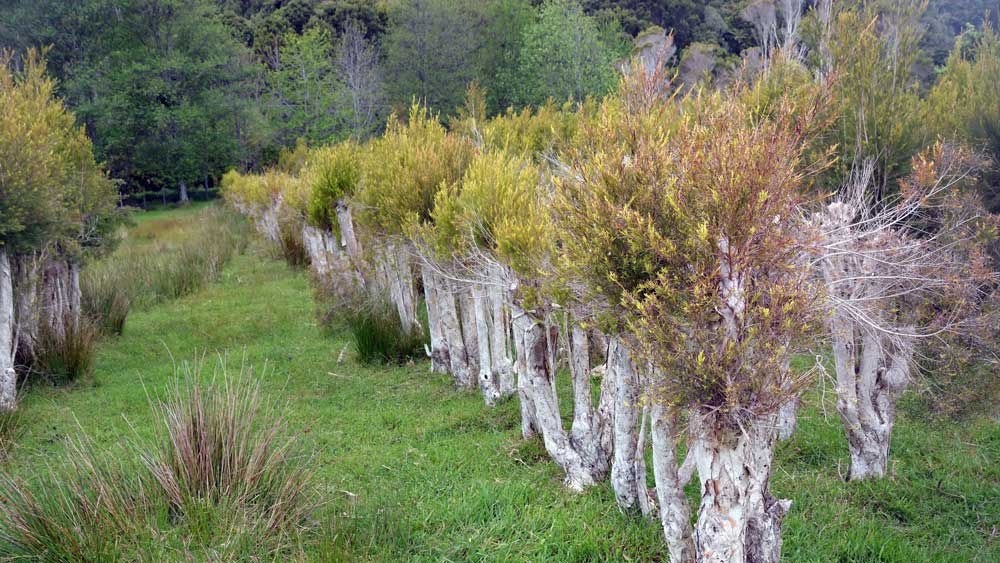

Hello, the article is very informative, but you don’t discuss why it is not one of the most popular acne treatments available today.